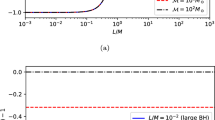Abstract
We provide a construction of a class of local and de Sitter covariant tachyonic quantum fields which exist for discrete negative values of the squared mass parameter and which have no Minkowskian counterpart. These quantum fields satisfy an anomalous non-homogeneous Klein–Gordon equation. The anomaly is a covariant field which can be used to select the physical subspace (of finite co-dimension) where the homogeneous tachyonic field equation holds in the usual form. We show that the model is local and de Sitter invariant on the physical space. Our construction also sheds new light on the massless minimally coupled field, which is a special instance of it.
Similar content being viewed by others
References
Feinberg G.: Possibility of faster-than-light particles. Phys. Rev. 159, 1089 (1967)
Schroer B.: The quantization of 0 > m 2 field equations. Phys. Rev. D 3, 1764 (1971)
Nachtmann O.: Dynamische Stabilität im de-Sitter-raum. Österr. Akad. Wiss. Math.-Naturw. Kl. Abt. II 176, 363–379 (1968)
Thirring, W.: Quantum field theory in de Sitter space. Acta Phys. Austriaca suppl. IV, 269 (1967)
Gibbons G.W., Hawking S.W.: Cosmological event horizons, thermodynamics, and particle creation. Phys. Rev. D 15, 2738–2751 (1977)
Chernikov N.A., Tagirov E.A.: Quantum theory of scalar fields in de Sitter space- time. Ann. Poincare. Phys. Theor. A 9, 109 (1968)
Bunch T.S., Davies P.C.W.: Proc. R. Soc. Lond. A 360, 117 (1978)
Allen B.: Vacuum states in de Sitter space. Phys. Rev. D 32, 3136 (1985)
Bros J., Gazeau J.P., Moschella U.: Quantum field theory in the de Sitter universe. Phys. Rev. Lett. 73, 1746 (1994)
Bros J., Moschella U.: Two-point functions and quantum fields in de Sitter universe. Rev. Math. Phys. 8, 327 (1996) ar**v:gr-qc/9511019
Dixmier J.: Représentations intégrables du groupe de De Sitter. Bull. Soc. Math. Fr. 89, 9 (1961)
Gel’fand I.M., Graev M.I.: Application of the method of horospheres to spectral analysis of functions on real and imaginary Lobachevsky spaces. Trudy Moskov. Mat. Obšč. 11, 243 (1962)
Takahashi R.: Sur les représentations unitaires des groups de Lorentz généralisés. Bull. Soc. Math. Fr. 91, 289 (1963)
Gel’fand I.M., Graev M.I., Vilenkin N.Y.: Generalized Functions: Integral Geometry and Representation Theory, vol. 5. Academic Press, New York (1966)
Molčanov V.F.: Harmonic anlysis on a hyperboloid of one sheet. Soviet Math. Dokl. 7, 1553 (1966)
Faraut, J.: Noyaux sphériques sur un hyperboloïde à une nappe. In: Lecture Notes in Mathematics, vol. 497. Springer-Verlag, Berlin (1975)
Polyakov A.M.: De Sitter space and eternity. Nucl. Phys. B 797, 199 (2008) ar**v:0709.2899 [hep-th]
Polyakov, A.M.: Decay of vacuum energy. ar**v:0912.5503 [hep-th]
Bros, J., Epstein, H., Moschella, U.: Lifetime of a massive particle in a de Sitter universe. JCAP 0802, 003 (2008). Particle decays and stability on the de Sitter universe. e-Print: ar**v:0812.3513 [hep-th]
Bros J., Epstein H., Gaudin M., Moschella U., Pasquier V.: Triangular invariants, three-point functions and particle stability on the de Sitter universe. Commun. Math. Phys. 295, 261 (2010)
Bertola M., Corbetta F., Moschella U.: Massless scalar field in two-dimensional de Sitter universe. Prog. Math. 251, 27 (2007) ar**v:math-ph/0609080
Erdelyi A., Magnus W., Oberhettinger F., Tricomi F.G.: Higher Transcendental Functions, vol. 1. McGraw-Hill, New York (1953)
Allen B., Folacci A.: The massless minimally coupled scalar field in de Sitter space. Phys. Rev. D 35, 3771 (1987)
Bernard D., Folacci A.: Hadamard function, stress tensor and de Sitter space. Phys. Rev. D 34, 2286 (1986)
Tadaki S.: Stress tensor in de Sitter space. Prog. Theor. Phys. 80, 654 (1988)
Miao, S.P., Tsamis, N.C., Woodard, R.P.: De Sitter breaking through infrared divergences. ar**v:1002.4037 [gr-qc]
Folacci A.: Zero modes, euclideanization and quantization. Phys. Rev. D 46, 2553 (1992)
Joung E., Mourad J., Parentani R.: Group theoretical approach to quantum fields in de Sitter space II. The complementary and discrete series. JHEP 09, 30 (2007) ar**v:0707.2907 [hep-th]
Author information
Authors and Affiliations
Corresponding author
Rights and permissions
About this article
Cite this article
Bros, J., Epstein, H. & Moschella, U. Scalar Tachyons in the de Sitter Universe. Lett Math Phys 93, 203–211 (2010). https://doi.org/10.1007/s11005-010-0406-4
Received:
Accepted:
Published:
Issue Date:
DOI: https://doi.org/10.1007/s11005-010-0406-4




